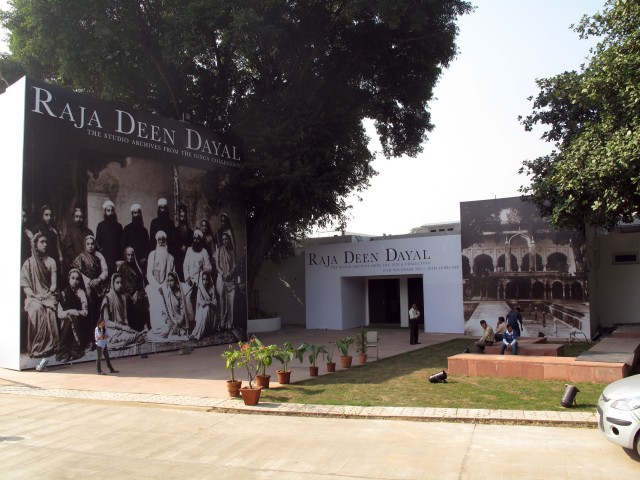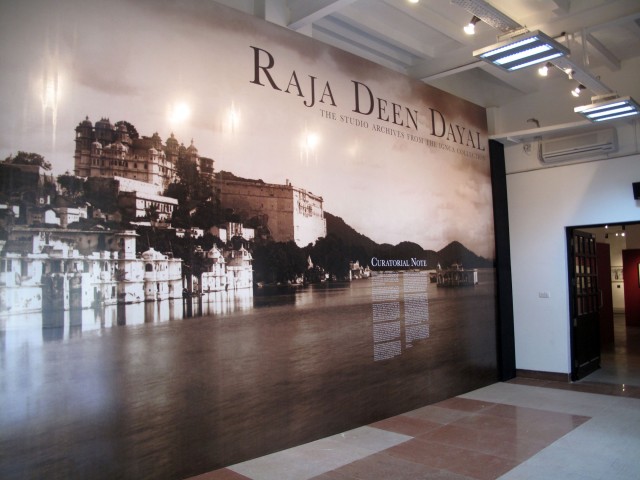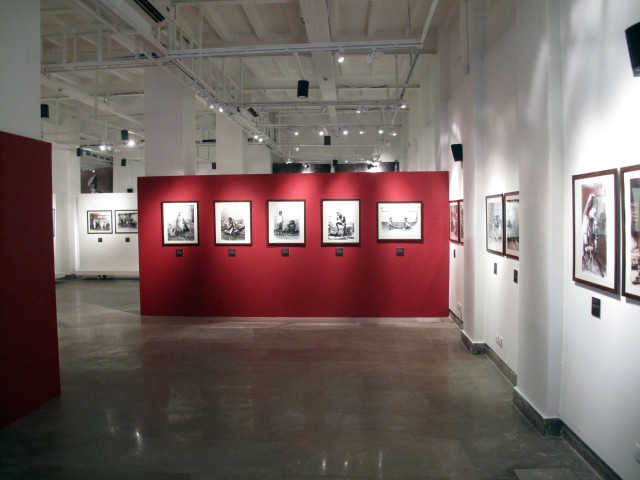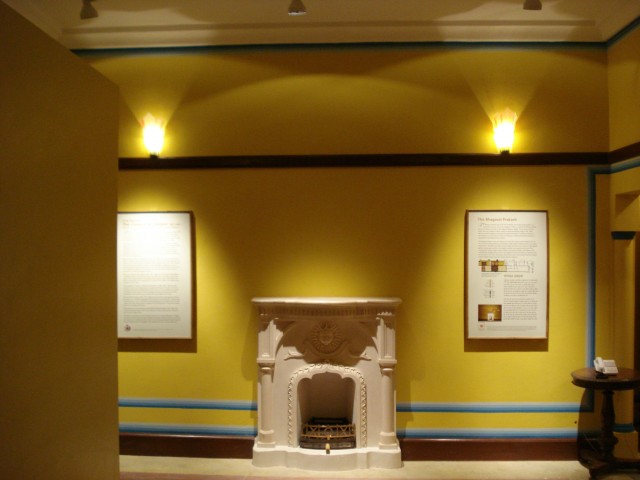Published in Context: Journal of the Development and Research Organisation for Nature, Arts and Heritage, Vol VIII, Issue 2 Autumn/Winter 2011.
An Unclaimed Legacy
Examining and exhibiting photographic archives in India
The journey of photography in India is not dissimilar to the process of its evolution around the world. Many of the early innovations in the field took place during the work of photographers in India at that time. Exhibiting historic photographs in India has brought out a range of questions that affect their showing. Some of the issues are purely technical but a lot of the challenge is in the search for a curatorial ideology. The chance to catalogue and document many important photography archives in India have thrown up a wealth of surprising original materials that need fresh attention and newer interpretations. The paramount idea that should ideally guide the study of photographs is to understand that a photograph is an object of history and not an accessory of history.
INTRODUCTION
In the absence of a major national photography collection in India or a centre dedicated to photography and its dissemination as a historic discipline, private collections, foundations and individuals have stepped forward and filled this space. These newer archives have begun looking at photography as a document of history and as an art practice both in its historic context and its contemporary avatar. The National Museum at Delhi does not have a photography department with a dedicated collection. What they do have is a reprographic department called the photography section that takes photographs of objects in the museum’s collection on requests. Some of the forums for photographic exhibitions in the country include the National Galleries of Modern Art across India and a slew of public and private galleries that periodically dabble in photography because of their mandate to promote art.
INDIAN PHOTOGRAPHY: EARLY HISTORY AND CURATORIAL VACUUM
The history of photography in India runs parallel to the history of photography across the world. The technical advancements made in the field from the 1840’s have several innovations credited to photographers working in India. The extreme heat, dust, harsh light, varied landscape, vagaries of protocol and the bewildering array of subjects, all contributed in creating a smorgasbord of solutions to the myriad problems faced by photographers. From photographing women within the cloistered confines of the Zenana to taking panoramas of cities at daybreak before the maelstrom of daily activity; cameramen and women have innovated with their technique and projected their gaze to portray original visions of India, not withstanding some of the more popular Orientalist stereotypes.
Exhibiting historic photographs in India throw up a range of questions that affect their showing. Some of the issues are purely technical but a lot of the challenge is the search for a curatorial ideology. Technical problems are usually related to the suitability of the environment for display and the possible cumulative damage photographic prints undergo due to their exposure to the elements in non-sterile environments. However, curatorial issues at play are far more nuanced and might seem baffling to a layperson. The fact that of all the major visual arts, photography is a relative newcomer might just be one part of the problem.
Over the last six years, I have been fortunate enough to be part of a nascent group of professionals who are working with historic photographic collections in India, almost all of them in the private sector. The chance to catalogue and document many of these photography archives in India has thrown up surprising results. The wealth of photographic record available is truly unprecedented across a wide range of formats and materials dating from the early years of photography in India. While the camera as we know it is was invented in 1839, the first known advertisements for daguerreotype portraits came up almost immediately in Calcutta (Kolkata) in 1840. The inaugural meeting of the Photographic Society of Bombay (Mumbai) in 1854 was soon to be followed with a photography class at the Elphinstone Institution in 1855 and by the setting up of photographic societies in Calcutta and Madras (Chennai) by 1856. It is indeed baffling that no concerted effort to retain this lead in photographic history was made in independent India and that in 2011 we are still grappling with issues of inadequate venues, improper lighting, photographic conservation technicians, archivists, framers, storage facilities, curators and critics. Amongst all our colonial baggage this was perhaps one area we would have benefitted by picking up on our historic legacy.

THE ALKAZI COLLECTION
My introduction to photographic archives began with the Alkazi Collection of Photography (ACP), a private trust based in Delhi with perhaps the foremost collection of photographs from the early days of the medium’s history in India. Its enviable collection dating from the mid 19th century onwards includes wax paper and glass plate negatives, daguerreotypes, albumin, platinum and gelatin silver prints, along with a range of cameras and other photographic materials.
The ACP’s collection is a vast repository of images from the British Raj and from informed purchases in auctions across the world and from dealers who brought Mr. Ebrahim Alkazi’s attention a vast treasure trove of photographic materials. The riches of the collection are further affirmed with the works of a slew of major figures in the history of photography. While names such as Samuel Bourne and Raja Deen Dayal are commonplace, the collection also holds important works by pioneering masters such as Felice Beato, John Murray and James Waterhouse. The works of these early photographers and their invaluable contribution to the field, combined with the fact that this material was now available for study in India meant that the onus on the ACP to exhibit was enormous. The collection has been largely documented. A long list of planned publications has begun and today they have a series of critically acclaimed books out, highlighting important aspects of India’s photographic history. An effective outreach mechanism was formulated and the foundation has been exhibiting originals and reproductions of its prints that accompany the release of each of its publications.
STORAGE AND CONSERVATION OF ARCHIVAL PHOTOGRAPHS
The showing of original 19th century prints in galleries overseas was not a problem, since most of these venues met with stringent lighting and humidity control levels as specified by conservators. The thought did cross my mind that these photographic prints were not stored in temperature controlled environments while in storage in India. However, the micro-climate at the Foundation was always stable and consistent. This was crucial since organic material like photographs deteriorate rapidly with fluctuations in temperature and light exposure. The impossibility of maintaining round-the-clock air conditioning because of frequent power outages and the prohibitive costs meant that most institutions maintained air conditioning for people and not for objects. Thus a nine-to-five working day meant that photographs went from a temperature of 22 degrees Celsius in the daytime to 40 degrees in the evening once the air conditioning was switched off. The damage to photographs in such an environment was huge and the Foundation decided on a pragmatic policy of keeping the photographs in a cool and stable non air conditioned environment. The summer and winter temperatures swings were gentled on the collection, as these were regulated by the gradual heating and cooling of the natural environment.
EXHIBITING CHALLENGES: THE ALKAZI COLLECTION
Similar concerns while exhibiting fragile 19th century photographic material in India meant that the showing of original vintage prints was restricted to venues like the National Gallery of Modern Art in Delhi and Mumbai. In most other cases, the foundation adopted the option of printing digital reproductions of original photographs. The decision to show reproductions in itself was not easy. Most international museums and galleries seldom accept exhibitions consisting of reproductions except for a stray reproduction or two in exhibitions consisting largely of original works of art. A carefully considered decision was taken to print very high quality reproductions of the vintage prints.
Contrary to popular perception, original photographs were not scanned to make copies. Photographs were digitally shot at very high resolution in controlled studio environments with great care taken to maintain tonal variations and contrasts in their reproduction. Several test prints were first executed to ensure that the colour range of the final print matched with the original photograph. Besides maintaining the tonal range of different photographers, it was also imperative to ensure that all the reproductions did not have one standard tone across all prints. The reproductions had to show different photographic processes of various eras that these were originally from. An image from the 1860’s differed vastly in colour from one of the 1890’s. By default, this insistence on perfect prints also necessitated fidelity in depicting the deterioration on the image due to ageing and poor handling. It was in exceptional cases that an irreparably deteriorated image needed cleaning up using Photoshop tools to restore the photographer’s original image in its reprinted version. This was however an exception rather than the rule.
The curatorial strategy now called for another problem solving exercise with questions about the size of the reproduction. Since images were being reproduced, would it not have made sense to reproduce them to the same size as the original? A differing and more pragmatic approach was adopted. As the displayed objects were copies, it made sense to show them in larger scale for people to be able to enjoy the depth of detail that these views had on offer. The strategy was a resounding success, with enthusiastic audience reactions at several venues across India such as Lucknow, Chennai and Mumbai, wherever the ACP exhibited the photographs, over a period of five years. Today, sizes for reproduction of vintage prints vary from 61 centimetres x 50.8 centimetres, 61 centimetres x 76.2 centimetres and 76.2 centimetres x 91.4 centimetres, depending on venue size and landscape or portrait format of image.
The most common feedback was that viewers felt they got a real sense of 19th and early 20th century India by being able to view large scale reproductions of people, places and monuments in the exhibition. Enlarged images seemed to convey a baffling reality and historical authenticity that perhaps smaller sized originals did not allow for. It was almost as if people could enter the photographs hung on the wall like a mise-en-scene and that somehow made it more real. If the goal was to reach out to newer audiences and disseminate a greater understanding of photography and its rich history in India, then the ACP’s gambit played out spectacularly, venue after venue. Criticisms were expected and these were usually from connoisseurs and sometimes from photographers who were unsure about the use of reproductions when originals were available. Another popular strategy was the reproduction of facsimile albums that people could thumb through with the original left open to a section and displayed close at hand in a glass vitrine.

RAJA DEEN DAYAL’S PHOTOGRAPHS
The lessons in exhibiting photographs, both originals and reproductions, was played out in a much wider dimension when I co-curated with Dr. Jyotindra Jain, photographic material from the Raja Deen Dayal archives held by the Indira Gandhi National Centre for the Arts (IGNCA) at Delhi. This large archive of works by a single pioneering photographer Raja Deen Dayal (1844-1905) meant that we were in a unique position to map out his journey across the photographic landscape of the country, with images from almost every time phase of his professional life. The fact that he had gone on to found an important studio across several cities in India and was universally acknowledged as the most important photographer of his time meant that audience expectations for viewing his photographic legacy was at an all time high. The Deen Dayal archives had been out of bounds for most scholars, since the IGNCA has acquired the collection from his heirs in 1989. True to the best of bureaucratic tradition in India and vicissitudes of working in India, the project was an elongated affair. The first surprise was that contrary to popular belief, the collection of ‘originals’ was largely of glass plate negatives and not of original prints. The few 19th century prints in the collection were crumbling and not worthy of display and other prints were from the period when Deen Dayal’s family ran the studio, much after his death. The original material was restricted to glass plate negatives which were however out of bounds for the curatorial team and we did not get to see it during the entire project. Nor was his extensive original camera equipment and studio registers made available to the curatorial team.


Field research across other collections in India with extensive Deen Dayal holdings allowed us to map his life, work and photographic practice. Inexplicably, the only material handed over for work was a DVD with low resolution images of the 2,857 glass plate negatives that had been originally printed in the silver bromide technique by the Deen Dayal family, before the collection was sold to the IGNCA. The choices for display were very clear. The only way the exhibition could be mounted was by printing reproductions and extensive details of how this was achieved are mentioned in the technical comment section of the exhibition catalogue titled ‘Raja Deen Dayal, The Studio Archives from the IGNCA Collection’. The curatorial strategy was very simple; to show images from the IGNCA collection that did not duplicate his already well known oeuvre, available in collections in India and other parts of the world. The exhibition that was held for three months at the large newly inaugurated venue of the IGNCA, was perhaps one of their most successful events. The attendance and enthusiastic reactions from lay audiences during the entire period of the exhibition have convinced me of the efficacy of showing large scale reproductions when conditions for showing originals are absent. Not showing originals is an option, but not showing reproductions is definitely not the answer if the idea is to popularise the medium of photography and its rich history in India.
THE UDAIPUR PALACE COLLECTION
One of the more interesting challenges in working with photography collections in India has been my work with the Pictorial Archives of the Maharanas of Mewar at Udaipur. The vast and extensive collection is tantamount to our understanding of the true state of photography collections in other former princely states in India. The Udaipur photography archives have remained virtually untouched and were maintained in the palace stores from the 1850s. Images in the collection document court proceedings and have captured many of the key players in court from the reign of Maharana Swaroop Singh (1842-61) onwards till the merger of the state with independent India in 1947 during the rule of Maharana Bhupal Singh (1930-47). The cataloguing covered more than 27,000 photographs in the collection. The cataloguing of the Udaipur archives has now set a role model for how photography collections can be collated and the riches of several collections be shared with and made available to the larger scholarly community.

Cataloguing of the collection also allowed for the creation of the first exhibition gallery dedicated to photography in any of the several palace museums within India. Working with a professional conservator also allowed us to create an environment that was non air conditioned but safe for the display of original vintage prints. Controlled light settings comparable to international standards were implemented and unique cost effective innovations were implemented to allow for the safe display of images. Detailed text panels at the Bhagwat Prakash Photography Gallery explain conservation methods in use at the gallery allowing for the safe viewing of historic material.
For visitors at the City Palace Museum Udaipur, the photography gallery comes at the far end of their tour of the museum. A fast trek around the 16th century palace complex takes at least one hour and visitor fatigue is very high by the time people get to the photography gallery. Visitors who do make it to the gallery are rewarded by what the new revamped galleries across the museum will look like in a few years’ time, as the photography gallery is the prototype of the museum’s renovation programme. One of the critical lessons from setting up the Udaipur photography gallery has been the realisation that a full-fledged gallery dedicated to photography needs a calendar of events so that a new show goes up when the safe period of exhibiting vintage prints is over. Photos that have been exhibited for substantial periods of time, ideally three months at 50 lux light exposure, need tobe put away to sleep for a substantial period before these are exposed to light or exhibited again. In effect, planning one exhibition means preparing for two shows within a time period of three to six months, allowing for a quick turnaround of shows. This is essential not just to satisfy visitor interest but also for the safekeeping of the collection. A delay in anticipating what would go up next meant that some of the original prints were on display for a year before reproductions were installed in the gallery.
PHOTOGRAPHIC ARCHIVES IN AND OUTSIDE INDIA
As evident, there are several issues at play in displaying original photographs at museum or quasi-museum venues. Due to lack of a concerted forum for discussion on curating and displaying photography, conservation standards meant for other visual arts are sometimes applied to the display of photographs. The stress and attention safeguarding this precious form of material culture might seem disproportionate to the time invested in curating and thinking of an exhibition story line while working with photographs. However, the importance of maintaining these archives underlines the fact that we have to leave something for future generations to interpret.
The history of photography in India has often been interpreted by collections that largely included photographs of India that were taken away by colonial masters or by ardent collectors. A lot of the material consists of photographs taken during British rule, by and for the Raj. The gaze of the photographer and very often of the interpreter or the curator is unequivocally that of an outsider looking at a society and a culture vastly different from theirs. Prevailing trends in taking photographs during the Raj were akin to their worldview of dominance with the stress being on the romantic, objectified and in pursuit of an exotic India.
Indians fed into every arrangement and configuration that an outsider could conceive. Very often a ‘native’ would go along to confirm a stereotype and play his part. In the hurry to interpret this visual history provided by photographs in collections outside India, images existing in archives across India of the same period, taken by local and foreign photographers for their Indian patrons with a different story to tell and a different India to show, got overlooked.
The last five years have been a very exciting time, with many archives, both in the former princely states and across other collections, being brought to public attention, with photographs presenting a more nuanced view of life in India. These show the camera’s lens documenting formal court proceedings in the 1860s where a distant monarch looked away to avoid his soul from being captured and a few decades down move to show a more convivial setting in the 1920s when a ruler was seen amidst his people staring into the lens. The camera captured people, places and pageants, often fulfilling the role of the miniature painter and of a bard. These two were traditional chronicler of events at courts and of society in a continuum of earlier histories.
CONCLUSION
In examining this rich repository of visual material across the length and breadth of India, there is enough material for several generations of scholars, researchers and curators. The vision to seek out this material without biases and equipping themselves with informed tools and fresh eyes is the larger challenge. The absence of an organised cabal of people in the larger photographic community in India could however be detrimental to this process if not redressed at the earliest. A national centre for the preservation, organised study and dissemination of the photographic history of India is an urgent necessity. The study of a photograph as an object of history and not as an accessory of history to explain a point or an argument is a distinction that needs to be understood.
My biggest learning over six years of research across photography archives has been an eye opener in my understanding of the medium and its history in India. These newly emerging archives show us an India barely understood, with a larger story of a visual culture that has been examined mostly through the prism of holdings held outside India. Though well documented and exhibited with a great deal of exacting research, these histories still do not give us the full picture. To get to a truer understanding of a photographic history of India, the two halves of collections in India and outside would need to be studied together, with equal vigour for us to even begin to comprehend this composite whole.
